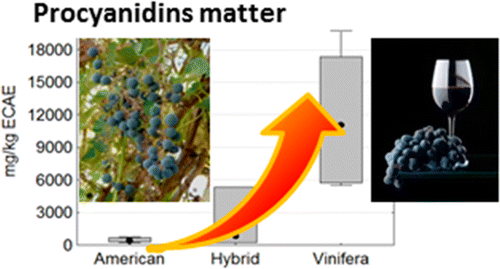Figuring out how to make tastier wines using fewer pesticides

Wine-making is steeped in age-old traditions, but to address the threat of pests and concerns over heavy pesticide use, vintners are turning to science. With the goal of designing better grape breeds, scientists are parsing the differences between wild American grapes—which make terrible wine but are pest-resistant—and the less hardy grape species pressed for fine wines worldwide. They report their findings in ACS' Journal of Agricultural and Food Chemistry.
With every sip of their preferred drink, wine lovers from across the globe are appreciating the taste of a single species of grape, Vitis vinifera. Although it comes in many varieties, or cultivars, the species remains largely unevolved and susceptible to pests. With growing concern over the potential harm that pesticides might cause and the rise in fungicide resistance, some winemakers are developing hybrid grapes that are a cross between the hardy, wild American types—such as Vitis californica—and vinifera. But no one had done a direct comparison of the two to see which traits winemakers should borrow from each to make the best wine grape. Fulvio Mattivi and colleagues wanted to fill that gap.
The researchers found that compared to the high concentrations in the vinifera varieties in the study, the American grapes had low levels of metabolites such as procyanidins that are considered crucial to the body and healthfulness of fine wine. They were also missing several compounds common in vinifera grapes that lead to appealing aromatic notes. But the American species were high in polyphenolic compounds called stillbenoids that are anti-fungal.
The particular hybrids analyzed in the study, however, contained low amounts of procyanidins and other desirable compounds. The researchers conclude that this kind of chemical profiling will help inform future breeding studies to design a better grape.
More information: Comparing Wild American Grapes Versus Vitis vinifera: A Metabolomics Study of Grape Composition, J. Agric. Food Chem., Article ASAP, DOI: 10.1021/acs.jafc.5b01999
Abstract
We analyzed via untargeted UHPLC-ESI-Q-TOF-MS the metabolome of the berry tissues (skin, pulp, seeds) of some American Vitis species (Vitis cinerea, Vitis californica, Vitis arizonica), together with four interspecific hybrids, and seven Vitis vinifera cultivars, aiming to find differences in the metabolomes of the American Vitis sp. versus Vitis vinifera. Apart from the known differences, that is, more complex content of anthocyanins and stilbenoids in the American grapes, we observed higher procyanidin accumulation (tens to hundreds of times) in the vinifera skin and seeds in comparison to American berries, and we confirmed this result via phloroglucinolysis. In the American grapes considered, we did not detect the accumulation of pleasing aroma precursors (terpenoids, glycosides), whereas they are common in vinifera grapes. We also found accumulation of hydrolyzable tannins and their precursors in the skin of the wild American grapes, which has never been reported earlier in any of the species under investigation. Such information is needed to improve the design of new breeding programs, lowering the risk of retaining undesirable characteristics in the chemical phenotype of the offspring.
Journal information: Journal of Agricultural and Food Chemistry
Provided by American Chemical Society




















